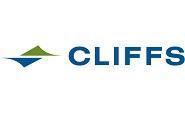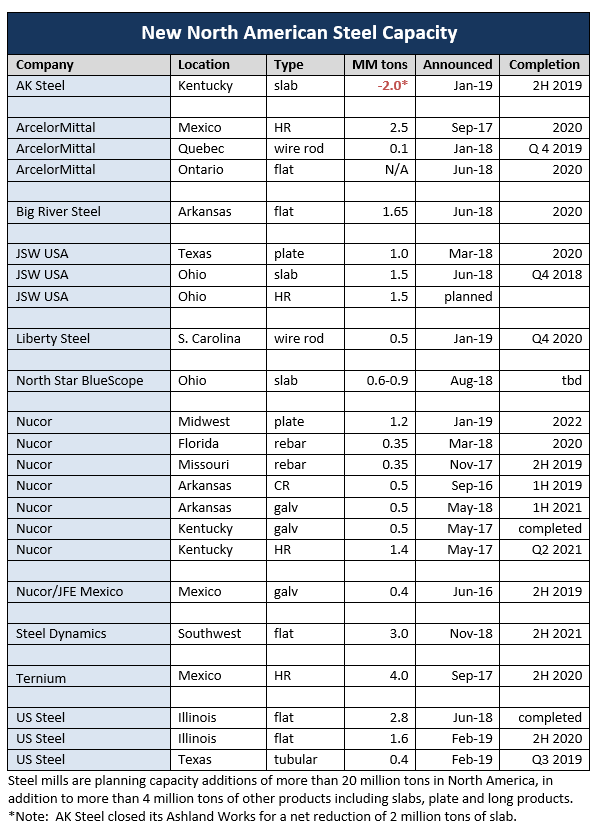Steel Mills

Like It or Not, U.S. Steel Industry Commits to New Capacity
Written by Sandy Williams
February 14, 2019
A strong economy and record profits are stimulating expansion in the U.S. steel industry. Often crediting President Trump for “leveling the playing field” with steel imports, companies like U.S. Steel and Nucor are taking the opportunity to reinvest their windfall in new and upgraded facilities.
Adding capacity in a world that is struggling with steel overcapacity can be a touchy subject for steel executives, who face criticism from those who fear oversupply will hurt steel prices. “We don’t add capacity simply to add capacity,” said Nucor Chairman and CEO John Ferriola. Capacity additions at Nucor “have a very specific, strategic objective—either lowering the cost, moving us up the value chain or getting us into new markets.”
Nucor is building rebar micro mills in Florida and Missouri and a 1.2 million ton capacity plate mill somewhere in the Midwest. It has upgraded galvanizing capabilities and is expanding hot band capacity from 1.6 million tons to 3 million tons at its Gallatin, Ky., facility.
Nucor’s joint project with JFE Mexico will add 400,000 tons of galvanized steel sheet for the Mexican auto industry. ArcelorMittal is also investing in Mexico, building a 2.5 million ton hot strip mill.
U.S. Steel has been on a multi-year upgrade and expansion program that culminated last year with the restart of the blast furnaces at Granite City. Just days ago, the company announced it will resume work on its electric arc furnace at Fairfield, giving President Trump credit for providing the right business conditions to move ahead on its delayed project.
Big River Steel, after aborting an offer to sell the company, decided to double its hot rolled production by adding a second EAF with 1.65 million tons of capacity. “You can schedule the mill better. You have less transitions. You get a huge bang for your buck when you double,” said Big River CEO David Stickler.
JSW USA will add a 1 million ton per year EAF adjacent to its pipe mill in Baytown, Texas, that will produce plate for what it considers an underserved market.
North Star BlueScope in Delta, Ohio, is waiting to hear from parent company BlueScope on whether it will receive the go-ahead for a third EAF and a second slab caster that would add 600,000 to 900,000 tons of additional capacity. A decision is expected later this month.
Other companies have announced capacity additions in tubular and wire rod.
CEOs are counting on at least a few more years of demand growth and diminished imports, despite steel prices that have fallen from their exorbitant highs of 2018 and Section 232 measures that are increasingly coming under attack for stifling downstream manufacturing growth.
The U.S. steel industry views Section 232 tariffs and quotas as a huge success. The downside is that they are temporary measures that can be withdrawn on short notice.
“It’s clear that Section 232…has been a success because the idea was to maximize capacity utilization and to encourage investments in the steel business in the U.S.,” said ArcelorMittal CFO and President Aditya Mittal. “So, there’s a little bit of a chicken or egg situation where you have the capacity now because of Section 232 and, therefore hopefully, it demonstrates to U.S. stakeholders that it is important to keep 232 for a longer period of time.”
U.S. Steel CEO David Burritt commented on the company’s revitalization program during the Q4 earnings call: “It’s not about capacity additions for us. It’s about utilizing our assets in the most effective and efficient way possible. We’re getting the extra tons not by adding excess capacity, but instead capitalizing on what we have.” Burritt doesn’t believe the administration will blink on tariffs. “We have a high degree of confidence that 232 will not be pulled back.”
So, how much capacity is being added? A lot, looking at the variety of mills and product lines that are being expanded, restarted or coming online new (see chart).
Between U.S. Steel, Steel Dynamics and Big River Steel about 6.2 million tons of flat roll capacity will be coming online in the next two years. The Ohio EAFs under consideration at JSW and North Star BlueScope would add an estimated 1.8 million tons of production. The two plate mills planned by JSW and Nucor total about 2.2 million tons. Then there are the long products additions…
The Wall Street Journal estimates that in total about 16 million tons of new steelmaking capacity is planned in the U.S., an 18 percent increase from the pre-tariff level of 90 million tons produced by domestic mills in 2017.
The subject of new mill capacity will be a focal point at this year’s SMU Steel Summit Conference in Atlanta on Aug. 26-28. We have a strong mill panel with Mark Millett, CEO of Steel Dynamics; John Hritz, CEO of JSW USA; and Ladd Hall, Executive Vice President, Flat Rolled, for Nucor. Each will be discussing their company’s additional capacity and the markets being targeted. We will have a separate panel with CRU, Steel Research Associates and Bank of America Merrill Lynch weighing in on what the new capacity will mean to the U.S. steel industry. Registration is now open.

Sandy Williams
Read more from Sandy WilliamsLatest in Steel Mills

Cliffs being selective with auto clients on strength in sector
With strength in the sector and customers needing the product it produces, Cleveland-Cliffs’ chief executive says the company will be more selective with the automotive customers it chooses to serve.

SDI Q1 earnings slip on order volatility, low scrap tags
Steel Dynamics Inc.'s (SDI's) earnings fell in the first quarter of 2024 as the company cited steel order volatility early in the quarter and lower scrap prices.

Nucor seeks to tame volatility with weekly HR spot price: execs
Nucor executives explained their recently introduced hot-rolled (HR) coil consumer spot price (CSP) is a way to serve their customers and deal with market volatility.

Goncalves, Granholm tout domestic steelmaking at Cliffs’ Butler Works
Cleveland-Cliffs’ chief Lourenco Goncalves and US Secretary of Energy Jennifer Granholm stressed the importance of the US steel industry and domestic manufacturing at Cliffs' Butler Works in Pennsylvania on Monday.

Nucor posts lower Q1 profits, predicts dip in Q2 too
Nucor’s earnings slipped in the first quarter of this year, but the company said it launched key growth initiatives during this time period.

